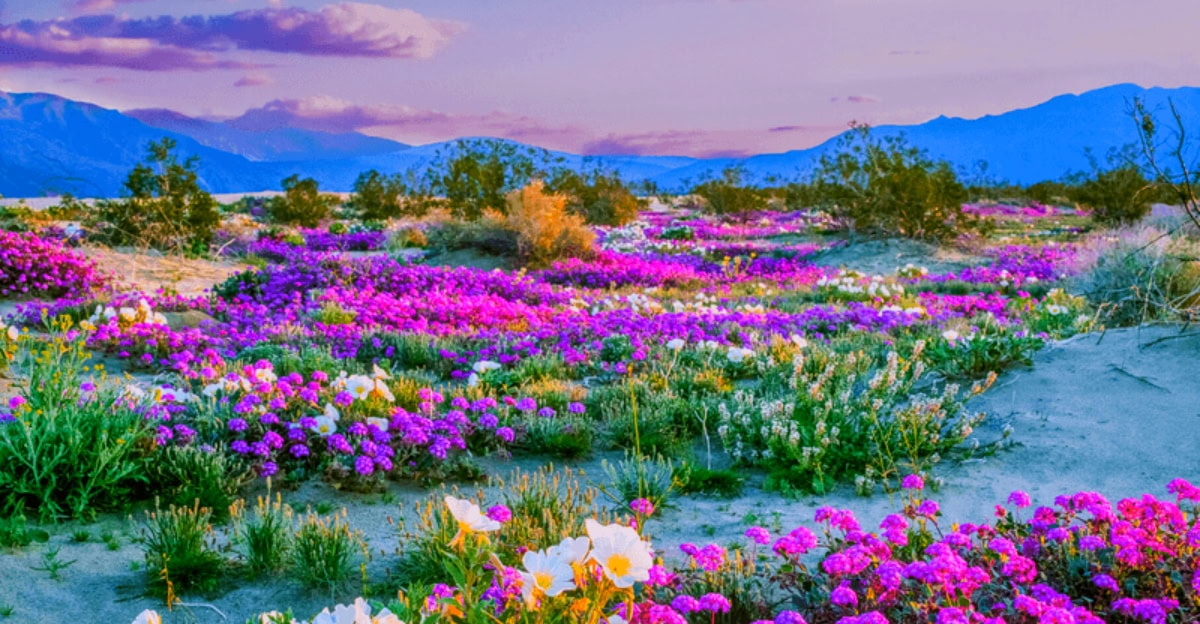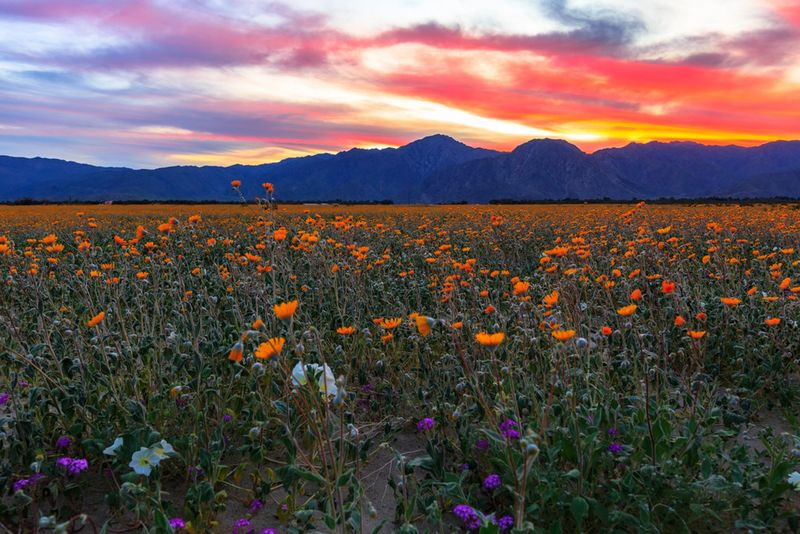Nestled between San Diego and Palm Springs lies a desert town that transforms into a breathtaking floral paradise each spring. Borrego Springs, surrounded by Anza-Borrego Desert State Park, becomes the stage for California’s most spectacular wildflower display when conditions are just right. This natural phenomenon draws thousands of visitors who witness the normally barren landscape burst into a kaleidoscope of vibrant colors, creating one of nature’s most magical and fleeting shows.
Nature’s Magical Canvas: The Super Bloom Phenomenon
When winter rains fall just right, Borrego Springs transforms from arid wilderness into a painter’s palette of wildflowers stretching as far as the eye can see. This rare ‘super bloom’ happens when perfect rainfall, temperature, and timing converge – sometimes occurring just once every decade.
Fields erupt with golden poppies, purple desert verbena, white evening primrose, and dozens of other native species. The normally brown landscape becomes a living rainbow against the dramatic backdrop of eroded badlands and distant mountains.
Wildflower enthusiasts track weather patterns with the devotion of storm chasers, ready to witness this fleeting miracle that typically peaks between late February and early April. When conditions align perfectly, over 200 wildflower species can bloom simultaneously across the desert floor.
Prime Viewing Spots: Where to Witness the Bloom
Henderson Canyon Road stands as the crown jewel of Borrego’s wildflower viewing locations. Here, carpets of desert sunflowers create seas of yellow that contrast dramatically with purple verbena and white primrose fields. The scene looks almost unreal – like someone spilled buckets of paint across the desert.
For those seeking less crowded experiences, Coyote Canyon and Borrego Palm Canyon offer stunning displays along their hiking trails. The visitor center wildflower garden provides accessibility for those with mobility concerns.
Morning light bathes the flowers in a golden glow, making it the photographer’s golden hour. Sunset brings another magical transformation as the low-angled light intensifies colors against lengthening shadows. Weekdays typically offer more peaceful viewing experiences away from weekend crowds.
The Small Town with Big Flower Power
During peak bloom, Borrego Springs transforms from a sleepy desert community of 3,400 residents into a bustling hub hosting over 200,000 flower enthusiasts. Local businesses thrive during these precious weeks – restaurants serve wildflower-inspired specials, gift shops sell bloom-related souvenirs, and accommodations fill to capacity.
The town embraces its identity as California’s wildflower capital with community pride. Rangers and volunteers staff information booths to guide visitors toward optimal viewing areas while educating about conservation. Metal sculptures of prehistoric creatures scattered throughout town create whimsical photo opportunities between flower viewings.
Despite the influx of visitors, Borrego Springs maintains its charming small-town atmosphere. The entire community comes together to celebrate and protect this natural wonder that puts their home on the ecological map each spring.
Timing Your Visit: The Wildflower Calendar
Mother Nature operates on her own schedule in Borrego Springs. The wildflower season typically kicks off in late February with desert lilies and other early bloomers emerging from sandy soil. March usually delivers peak displays when most species flower simultaneously across the landscape.
Rainfall patterns from the preceding winter months determine bloom intensity. Years following drought might produce modest displays, while seasons after abundant gentle rains can trigger spectacular super blooms. The Anza-Borrego Desert Natural History Association maintains a wildflower hotline (760-767-4684) offering weekly updates on bloom conditions.
Altitude creates a rolling bloom schedule – lower elevations flower first, followed by higher areas as temperatures warm. This extends viewing opportunities for travelers flexible with their timing. Even after peak bloom, the desert offers cactus flowers and other late-season botanical treasures.
Respectful Bloom Tourism: Preserving Desert Beauty
The delicate ecosystem supporting these magnificent blooms requires thoughtful visitation. Staying on designated trails prevents damage to fragile root systems and protects soil crusts that take decades to form. Photography enthusiasts capture stunning images without trampling flowers by using zoom lenses rather than walking into fields.
Early morning or late afternoon visits reduce impact during cooler hours while offering superior lighting conditions. Packing out all trash and avoiding picking flowers ensures these natural displays remain intact for future visitors to enjoy.
Local conservation organizations lead educational walks teaching about desert ecology and wildflower identification. These guided experiences foster deeper appreciation for the remarkable adaptation strategies desert plants have evolved. Participating in citizen science programs like wildflower counts contributes valuable data to researchers monitoring climate change impacts on bloom patterns.









